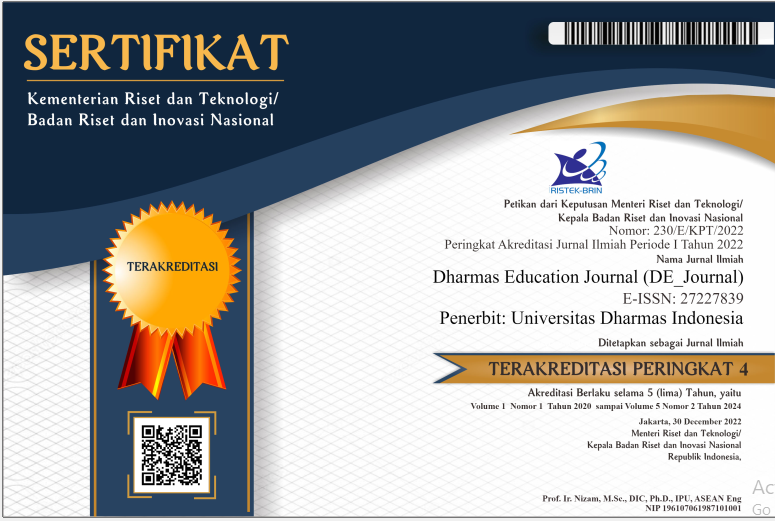IDENTIFICATION AND FACTORS CAUSING LEG LENGTH DISCREPANCY (LLD) INJURIES IN CENTRAL SULAWESI SEPAK TAKRAW ATHLETES
DOI:
https://doi.org/10.56667/dejournal.v4i2.1160Keywords:
Identification, Injury, Leg Length Discrepancy, Sepak TakrawAbstract
Long legs on one side or called Leg Weight Discrepancy (LLD) is a condition where there is a difference in the length of the lower extremities (legs) from one another. LLD can occur in athletes caused by intrinsic and extrinsic factors. The purpose of this study is to identify the types of LLD and the factors that cause injuries to Central Sulawesi sepak takraw athletes. This study employs a descriptive methodology and a quantitative research design. The research subjects were 24 athletes. Results that will be generated in the form of scholarly articles published in National Journals with accreditation / National Proceedings. They orient the target of this research towards Athletes. The data collection technique uses a questionnaire as the instrument, to determine LLD by measuring the length of the right and left leg using the true leg length technique. Therefore, it is anticipated that this research will be completed to 100% so that coaches and athletes can use it to inform their training. Most of the Central Sulawesi Sepak Takraw Athletes suffered LLD injuries of 68.75% (11 athletes), while those who were not injured or normal were 31.25% (5 athletes). Intrinsic factors account for 52.14% of the factors that cause injuries that frequently affect athletes from Sepak Takraw and extrinsic factors of 47.86% with the following description: regulatory factors and the character of the sport with a percentage of 19.50%, then physiology at 18.91%, social at 16.69%, psychology along with tools and facilities at 16.54%, and factors causing injury due to weather as the least common cause of injury, which is 11.82%.
Downloads
References
Ahmad, J., & Asry, S. (2014). Teknik Dasar Permainan Sepak Takraw (1st ed.). Ombak.
Alfuth, M., Fichter, P., & Knicker, A. (2021). Leg length discrepancy: A systematic review on the validity and reliability of clinical assessments and imaging diagnostics used in clinical practice. PLoS ONE, 16(12 December), 1–20. https://doi.org/10.1371/journal.pone.0261457
Anggriawan, N. (2015). Peran Fisiologi Olahraga Dalam Menunjang Prestasi. Jurnal Olahraga Prestasi, 11(2), 8–18. https://doi.org/https://doi.org/10.21831/jorpres.v11i2.5724
Arikunto, S. (2013). Metode Penelitian kuantitatif kualitatif dan R&D (1st ed.). Alfabeta.
Ayuningtiyas, C. (2020). Regulasi Emosi Siswa Dalam Pembelajaran Daring. Dharmas Education Journal (DE_Journal), 1(2), 107–113. https://doi.org/10.56667/dejournal.v1i2.123
Ismunandar, H. (2020). Cedera Olahraga pada Anak dan Pencegahannya. JK Unila, 4(1), 34–44. https://doi.org/s://doi.org/10.23960/jkunila4134-44
Khairunnisa, A., & Pitriani, P. (2019). Sepaktakraw Players Injuries Event. JUARA : Jurnal Olahraga, 5(1), 1–7. https://doi.org/10.33222/juara.v5i1.624
Khamis, S., & Carmeli, E. (2017). A new concept for measuring leg length discrepancy. Journal of Orthopaedics, 14(2), 276–280. https://doi.org/10.1016/j.jor.2017.03.008
Kurniawan, A. (2016). Peran Pencegahan Cedera Dalam Mendukung Performa Atlet. Indonesia Sport Medicine Center, 1–6. http://seminar.uny.ac.id/semnasor2016/sites/seminar.uny.ac.id.semnasor2016/files/Dr. Andi Kurniawan Sp.KO_.pdf
Parwata, I. M. Y. (2015). Kelelahan dan Recovery Dalam Olahraga. Jurnal Pendidikan Kesehatan Rekreasi, 1(1), 2–13. https://doi.org/https://doi.org/10.59672/jpkr.v1i1.2
Prabowo, T., Agustian, B., & Sari, D. M. (2022). Leg Length Discrepancy. IndoJPMR, 11(1), 1–12. https://doi.org/10.1016/S0966-6362(01)00148-5
Pristianto, A., Saffanah, D. N., Radinda, I., & Sari, D. R. K. (2023). Edukasi Pencegahan Dan Penanganan Cedera Olahraga Pada Tim Futsal Sman 1 Rangkasbitung. Jurnal Abdi Masyarakat Universitas Kadiri, 6(2), 86–95. https://doi.org/https://doi.org/10.30737/jaim.v6i2.3726
Purwanta, Y. (2016). Hubungan Panjang Tungkai dan Kekuatan Otot Tungkai dengan Jauhnya Tendangan Dalam Permainan Sepakbola pada Pemain PS Romberz Bantul Usia 16-18 Tahun [Universitas Negeri Yogyakarta]. In Universitas Negeri Yogyakarta: Vol. (Issue). http://eprints.uny.ac.id/id/eprint/37564
Putra, D., Neldi, H., Syampurma, H., & Zalindo, A. (2023). Analysis of the impact of massage , physiotherapy , and nutrision provision of recommended dietary allowances on the confidence of road race cycling athlete. Jurnal Olahraga Prestasi (JORPRES), 19(2), 103–116. https://doi.org/10.21831/jorpres.v19i2.65747
Rizmayanti, B. L., & Kusnarto, K. (2022). Peran Komunikasi Interpersonal Pelatih Dengan Atlet Menembak Club Brawijaya Sc Dalam Meningkatkan Prestasi Pada Kejuaraan Nasional “Antar Club 2022” Di Tengah Pandemi Covid-19 Era New Normal. Jurnal Ilmiah Ilmu Komunikasi Communique, 5(1), 70–82. https://ejurnal.stikpmedan.ac.id/index.php/JIKQ/article/view/125
Sabharwal, S., & Kumar, A. (2008). Methods for assessing leg length discrepancy. Clinical Orthopaedics and Related Research, 466(12), 2910–2922. https://doi.org/10.1007/s11999-008-0524-9
Setiawan, F. R., Sugihartono, T., & Nopiyanto, Y. E. (2022). Kontribusi Daya Ledak Otot Tungkai Terhadap Kemampuan Smash Atlet Sepak Takraw Pada Ekstrakurikuler di Smp Negeri 12 Kota Bengkulu. 3(2), 226–239. https://doi.org/10.33369/gymnastics
Sugiono, P. D. (2014). Metode penelitian pendidikan pendekatan kuantitatif.pdf. In Metode Penelitian Pendidikan Pendekatan Kuantitatif, Kualitatif Dan R&D (p. 12).
Suharjana. (2013). Kebugaran Jasmani (1st ed.). Jogja Global Media.
Widhiyanti, K. A. T. (2018). Cedera Olahraga : Pencegahan dan Perawatan (1st ed.). Pustaka Panasea.
Yavuz, İ. A. (2022). Leg Length Measurement with Smartphone Application during Surgery: Useful, Easy and Reliable Method. Eskisehir Medical Journal, Eskisehir City Hospital, 3(2), 205–211. https://doi.org/10.48176/esmj.2022.72
Downloads
Published
How to Cite
Issue
Section
License
Copyright (c) 2023 Dharmas Education Journal (DE_Journal)

This work is licensed under a Creative Commons Attribution-NonCommercial-NoDerivatives 4.0 International License.
Makalah yang disampaikan diasumsikan tidak mengandung bahan propietary yang tidak dilindungi oleh hak paten















